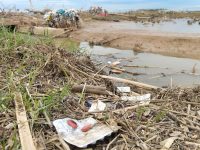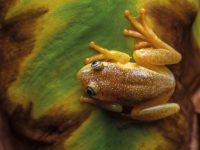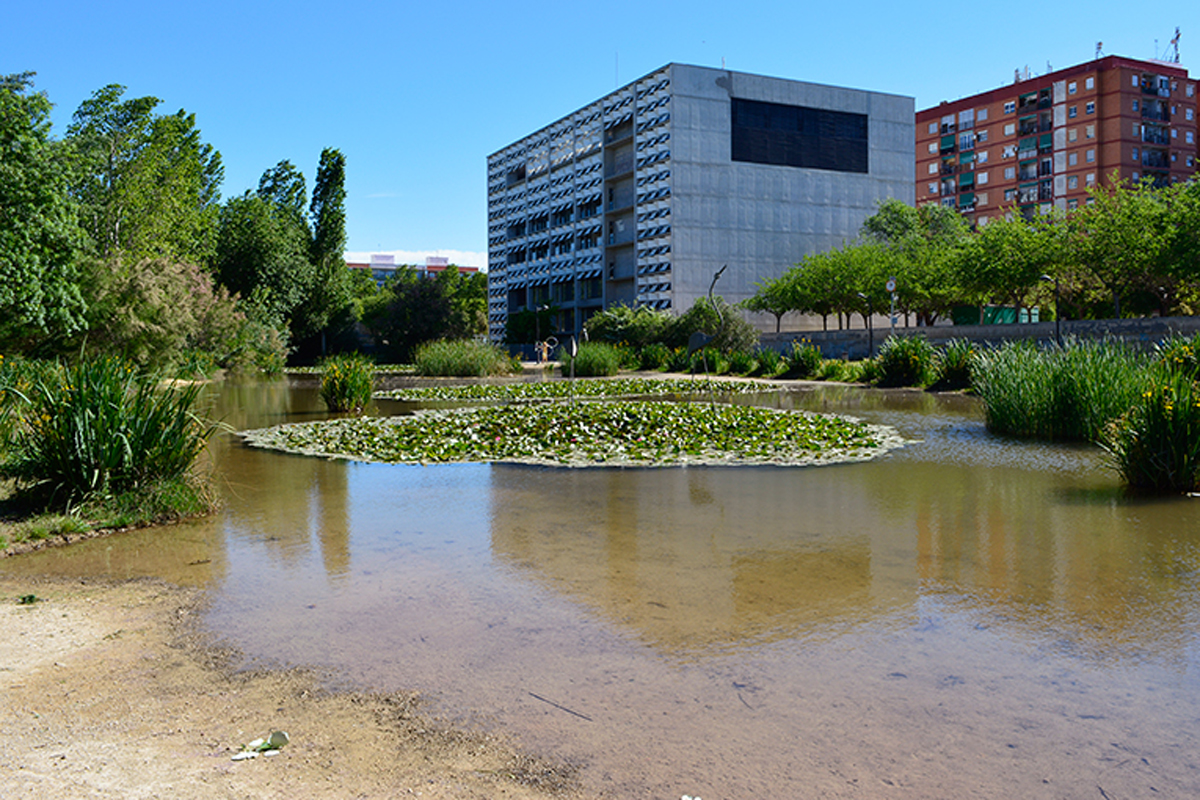
 Laura Villoria Laura VilloriaParc de la Rambleta, in the San Marcelino neighbourhood in Valencia, is a reference for the conservation of local biodiversity. |
||
|
The climate change, pollution, deforestation or the loss of biodiversity are phenomena that have, for some time, been taken into account in the preparation of environmental projects in urban areas. In a world where 54% of the current population resides in urban areas, and where this figure is expected to increase to 66% by 2050 according to the UN, the importance of the city in the management of these issues increases. We have to add to these considerations the estimates that indicate that between 2000 and 2030 the total urban area will triplicate. Said increase of population and urban areas will be globally detrimental for natural resources, seriously affecting the biological diversity and the services of ecosystems. This will be heightened in areas with low economic and human capacity, where it is estimated that the greatest urban expansion will occur in spite of having serious limitations for the formulation of policies for the conservation of biodiversity and the management of the services of the ecosystems. With these issues, there have been many alternatives proposed with regards to the design of green areas in cities. Designs that would be capable of facing the loss of biodiversity and of making the most of the services of the ecosystem, such as the reduction of pollution, the drop in temperature, the increase of shaded areas, the use of rainwater, the mitigation of the emissions of greenhouse gases, etc. A management of urban ecosystems focused on the conservation of biodiversity is also an opportunity to favour the increase of autochthonous animal and plant species, as well as the restoration of local ecosystems that have been degraded or are in danger. Valencia, a new experience in urban biodiversity The city, as administrative entity, is in charge of supplying and redistributing the services in order to deal with the inequalities and sanitary issues associated with urban areas. Urban ecosystems and their benefits for the well-being of the population are part of these services. However, in the last years of urban gardening the ecological aspect has not taken precedence in the design of green areas in most Southern European cities. Parks with green grass meadows – a mixture of Gramineae – and scattered trees, typical landscapes from Northern Europe with high maintenance cost have become popular in the Mediterranean climate. Such maintenance requires large quantities of irrigation and continued pruning, which prevents the growth of new species and the formation of seeds that may attract local animals. From the point of view of biodiversity and, subsequently, the quality of the ecosystem’s services, this type of designs are not interesting. The city of Valencia is no exception to this form of traditional design, where the creation of natural spaces does not follow criteria that cater to the conservation of biodiversity and its services. To discuss this situation we have spoken with Ximo Sánchez, technician from the Gardening Service of the Valencia City Council, with whom we have visited two completely different parks within the city: Parque de Cabecera, located between Valencia and Mislata at the beginning of the Turia Gardens, and Parque de la Rambleta, in the San Marcelino neighbourhood. |
«In the last years of urban gardening the ecological aspect has not taken precedence in the design of green areas in most Southern European cities» | |
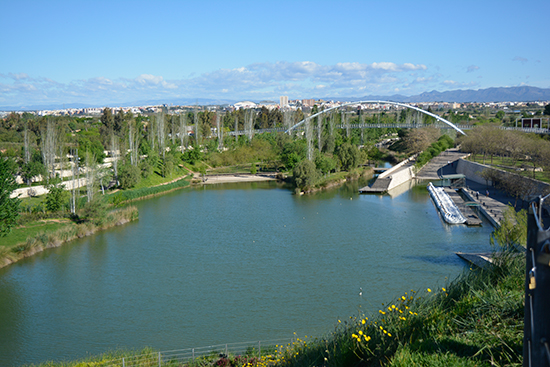 Laura Villoria Laura VilloriaOne of the most common practices is waterproofing the riverbeds with concrete. In the picture, Parque de Cabecera. |
||
|
Parque de Cabecera is one of the many examples of green areas that were not designed to preserve biodiversity. One of the inconsistencies the park presents – as Ximo Sánchez explains – is the relationship of the water with the riverside forest and the rest of the species. This type of forest is characterised by being dependent on watercourses such as rivers, growing along its shores or banks. Such is their bond that the forest’s water needs are practically met by the moisture in the soil of the bank, without the need of rain as its main water source. Some of the characteristic trees of this forest include willows, black poplars, ashes and, further from the shore, elms. However, the water of the Parque de Cabecera does not come into contact with the soil surrounding it, which tries to emulate this riverside forest. This is something very common in all the city’s parks, according to the technician Ximo Sánchez: waterproofing the basin of rivers and dams with concrete, preventing the direct hydration of the soil through the riverbed. Together with the typical landscape with wide grass areas that the parks present, this makes it necessary to have continuous maintenance through direct or drip irrigation hydrating the soil and the vegetation, with the great economic cost and the hydrological deficiencies that entails. The technician’s criticism of such an extensive and normalised use of grass is clear. It is also clear with regards to the maintenance system followed by these traditional parks, which little by little, he tells us, «must be changed due to economic, but also ecological, necessity, so as to increase the biodiversity and a more natural maintenance of the parks». An example of this is the negative view we have about grasslands and plants that grow outside of the idealised design we have of these areas. The removal of the so-called weeds is something much demanded by society, even alleging abandonment of the area. «It is necessary to speak positively of these plants», explains Ximo Sánchez, «and show that many of them are beneficial to increasing biodiversity, including the fauna they attract, and even improving the park’s maintenance». One of the objectives of this park is to be a relaxation and recreational space for people. Ximo Sánchez claims that much: «Each park has some objectives in its project idea. Parque de la Rambleta is above all a representation of the local flora. It is a park designed for the wildlife to find food and shelter. And in the Parque de Cabecera that is also partly the goal, but not the main objective. Nor is it in its design, more artificial. This is a very clear difference between both parks.» The Parque de la Rambleta is, indeed, a completely different idea to that of an unban park. Up to 30% of its surface is solely intended for fauna; the vegetation of this surface is designed in a way that does not allow visitors. The remaining 70% is the surface of grasslands and meadows with trees, which can be walked on. The design contemplates three landscape units, which are, from biggest to smallest distance to the course of water, the Mediterranean forest and scrub – representing the Dehesa del Saler’s ecosystem –, the elm grove and the riverside forest typical of the Mediterranean coastal area. All these landscape units have in their design commitment with the local flora and fauna species. They are not designed following a pattern in the presence of trees and vegetation, as is common in parks. There are also exotic plants, but these already existed in the area before the construction of the park. The maintenance of this park is also different from the conventional way in relation to the pruning of the grasslands. These, even more so for some time, are thoroughly maintained to improve the drainage and quality of the soil, benefiting the health of trees and shrubs and at the same time contributing to increasing biodiversity. Seeds are left to be produced and to grow, attracting different local wildlife species to profit from it. With the arrival of the summer, the pruning starts. Many of the herbaceous species die when this time comes, leaving their seeds dormant in the soil until the arrival of better weather conditions in the autumn. In the pruning the remains of these plants are left on the ground, causing the decomposition of organic matter and improving the soil’s fertility. Another great difference of Parque de la Rambleta with regards to other parks of the city is its water source, the ravine. It is a watercourse leading to a lake whose water is in contact with the soil, since its basin is not waterproofed. This makes the riverside forest, which grows in its surroundings, to be directly hydrated by the water, its density and quality being remarkable, which also translates into a better maintenance. The City Council’s technician, Ximo Sánchez, explains that the park comes from the ideas brought up in the Rio de Janeiro Earth Summit in 1992: «It was a way to apply that global concern about protecting biodiversity in the city of Valencia. But even today, this idea is still an uninteresting subject. Despite the fact that we have been saying for more than twenty years that we have to preserve and promote biodiversity, people are now starting to incorporate this principle in some European cities». |
«Parque de Cabecera is one of the many examples of green areas that were not designed to preserve biodiversity» | |
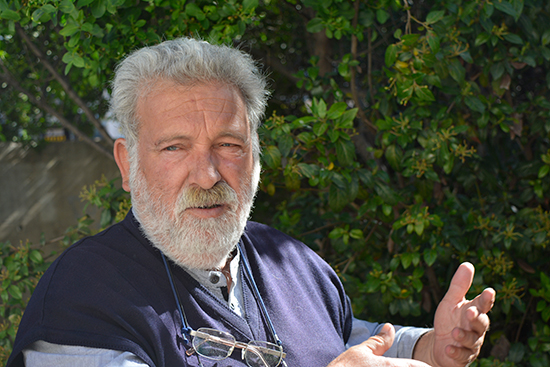 Laura Villoria Laura VilloriaWith Ximo Sánchez, tecchnician from the Gardening Service of the Valencia City Council, we visited two parks of the city with a completely different design: Parque de Cabecera, between Valencia and Mislata, and Parque de la Rambleta, in the San Marcelino neighbourhood. |
||
|
But what is exactly the role and capacity of a city to face this challenge? «As the city makes natural landscapes its own and incorporates them in its space, people get used to them with the urban code, equally respecting this landscape in its natural context. That is the importance of the city. Our society is fundamentally urban, and urbanity prevails. That is why the city cannot escape this commitment, it has to accept it». Nevertheless, he tells us that there does not seem to be a serious commitment to changing the management of parks and gardens focused on the preservation of the local biodiversity. However, the economic crisis has caused the rethinking of this model of management, creating and developing new projects that may be a step towards a new model of the relationship between nature and city. The differences between Parque de la Rambleta and other parks in the city of Valencia do not end just in its design and its objective of preserving local biodiversity. The park neighbours have taken it as their own, proving their concern for its state, its expansion and the services it generates for the entire neighbourhood throughout the years. The neighbours themselves participate in the management and design of the park. They propose projects to try to solve the problems that arise in the stages of expansion of the terrain and they demand that they be carried out. Their demands also include a proper care of the park and a good relationship with its neighbourhood. One of the last demands made from the Neighbours Association of the San Marcelino neighbourhood was addressing the problems caused by the arboreal vegetation. It showed clear signs of bad health due to a problem of soil compression, which resulted in a worrying decrease and reduction of its crown. Another of the problems they have reported is the lack of surveillance to prevent bad practices that endanger the health of the park’s ecosystem. An example of this was the dirty water at the end of the river course, caused by the usual practice of throwing food to fish and birds. The Neighbour Association of San Marcelino states that from the first moment there has been an involvement of the people of the area in the management and design of the park. In fact, after many claims by the Association to the City Council, the neighbours participated in the construction project of the park, which was opened in 2002. Over time activities aimed at preserving the park have been carried out with the participation of children and adults, such as the replanting of plant species. This involvement grew even more actively when, a little over a year ago, the Association warned of the bad health of the trees. The concern over the deterioration led them to start a series of interviews with the people in the neighbourhood to ask them about their opinion on the state of the park. As a consequence of this and their demands to the City Council, in October last year they started a course in biodiversity with Ximo Sánchez to learn more about the park’s ecosystem and to better understand its state. As explained by Rosa Ramón Puchades, who has participated in the environment and biodiversity area of the Neighbourhood Association: «The idea of the course came from the concern of the neighbours over the park’s health and state. When we have a closer understanding of the park and of the natural processes that take place in it, the intention is to continue transmitting this knowledge to all the neighbourhood». Besides knowing and recognising the different plant species and their relationship with the wildlife, one of the group’s objectives, she tells us, is to really know the importance of the park for the preservation of the local biodiversity. Compared to other parks in the city, the park is well received by neighbours and other visitors for its natural appearance. Feeling surrounded by nature and being able to appreciate and learn this kind of landscape, as well as enjoying the calm offered by the park, which seems isolated from the urban environment, is one of the services they value most. |
«As the city makes natural landscapes its own and incorporates them in its space, people get used to them with the urban code, equally respecting this landscape in its natural context» (Ximo Sánchez) «Compared to other parks in the city, the park is well received by neighbours and other visitors for its natural appearance» |
|
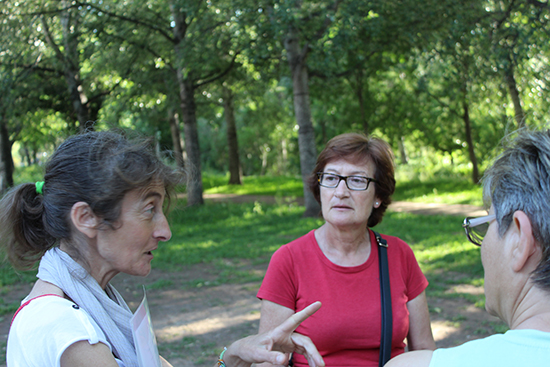 Juli Zacarés Juli ZacarésRosa Ramón Puchades, on the left, is one of the participants in the environment and biodiversity area of the San Marcelino Neighbourhood Association. |
||
|
While the members of the Association visit the park, they review their notes and try to identify the different species of plants and buds that are starting to appear. Thanks to what they have learned in the course they are able to explain some of the natural processes that occur in the park’s ecosystem. An example of this is the compression problem of the soil, which affected the health of the trees, which had decreased their crown. This was one of the reasons why their concern over the park’s state grew. Now they understand what caused the problem and how a different maintenance, like letting the grasslands of the soil grow, can help correct it. In fact, they have been involved in the protection of the affected soil to temporarily protect them from the tread of visitors and to accelerate its recovery. Rosa Ramón explains that she now feels more involved in what goes on in the park: «Now that I have a better understanding I think that if we now saw some inappropriate actions we would raise our voice, we would intervene. From this broader understanding we have the chance to manage, not just to accept what others tell us. And if we have to act, we can do so». Even their thinking regarding the established gardening rules, such as continuously removing the grasslands, has changed. Learning to see directly what the natural processes are and how they take place in nature makes them connect more with nature and learn to appreciate and take care of it when they leave the city. When asked if this kind of actions could take place in other areas of the city of Valencia they say yes, that they are proof of it. They see it as a great step towards a relationship with nature that they think is necessary in the urban environment. |
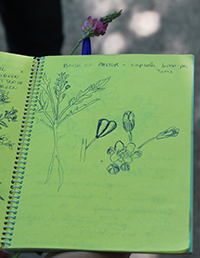 Juli Zacarés Juli ZacarésIn October last year, the neighbours started a course in biodiversity with Ximo Sánchez to learn more about the park’s ecosystem and to better understand its state. |
|
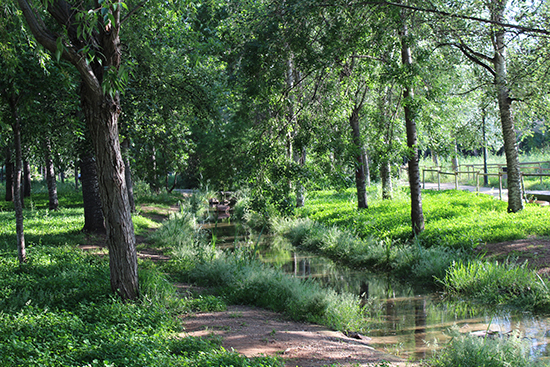 Juli Zacarés Juli ZacarésUp to 30% of its surface is solely intended for fauna; the vegetation of this surface is designed in a way that does not allow visitors. The remaining 70% is the surface of grasslands and meadows with trees, which can be walked on. |
||
|
The opinion of the neighbours regarding citizen involvement in the management of the services and the preservation of biodiversity is clearly very positive. They feel involved in a different way when using, enjoying and even managing the green areas of the city. The assimilation of these spaces as our own is essential for their continuity and respect. A better understanding and relationship with nature can encourage a change in the design and the maintenance of the urban parks and gardens. This is fundamental for the preservation of the local biodiversity and the improvement of the quality of its services. Starting to make projects where nature has a place in the city gives the chance of making these spaces public and of interacting with them, introducing the awareness of the need to protect them in the natural environment. The examples of urban areas aimed at promoting biodiversity are, for the moment, scarce. The other example to highlight in the city of Valencia, where it is intended to represent the local biodiversity, is Parque de Marxalenes. However, more and more initiatives where the preservation of nature and the approach to it are the main objective are emerging. Perhaps Parque de la Rambleta is an isolated example, but it may well mean a step towards a commitment with another way of understanding the role of the city and its inhabitants in the management of biodiversity. A management that does not mean its destruction. Juli Zacarés i Perea. Biologist and student of the Master in the History of Science and Scientific Communication. University of Valencia. |
«Perhaps Parque de la Rambleta is an isolated example, but it may well mean a step towards a commitment with another way of understanding the role of the city and its inhabitants in the management of biodiversity»
|
|

